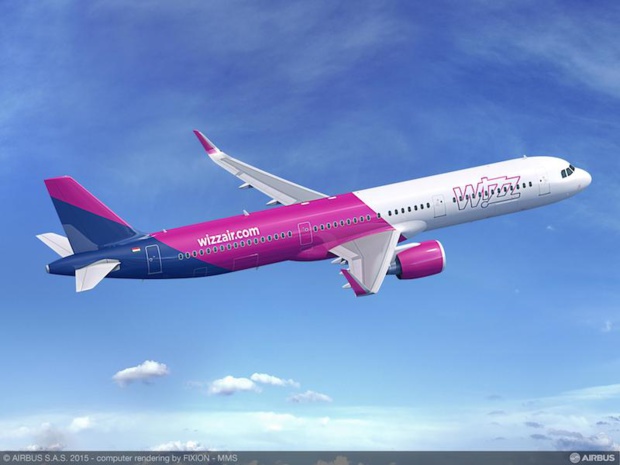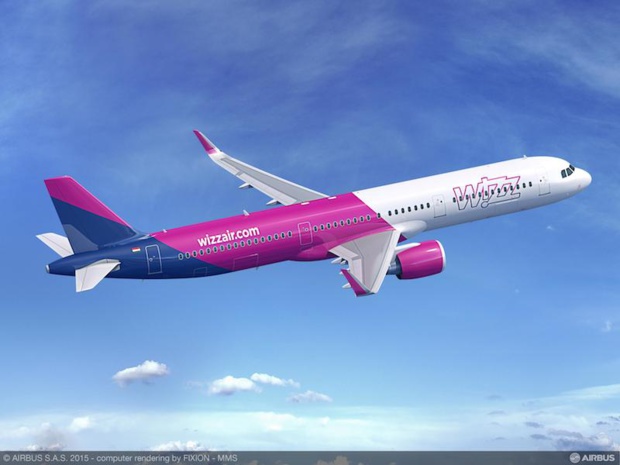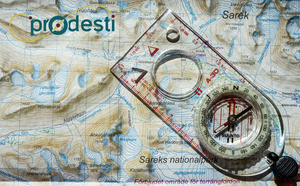
Wizz Air crossed the line of 100 million transported passengers since its creation - Photo: Wizz Air
On October 20th, 2015, Wizz Air took a symbolic turning-point.
Having transported over 100 million passengers since its birth in September 2003.
While it is still far behind the famous Ryanair and its 180 million passengers annually, the company, with its purple planes, is slowly but surely building itself a very powerful network.
Today, it serves over 110 destinations in 38 countries, including Paris-Beauvais, Grenoble in Winter, along with Bâle-Mulhouse.
By next March, it will takeoff from Nice, with 30,000 seats sold to Budapest.
“We would like to both seduce the Hungarians who wish to visit the South of France and the inhabitants of the Nice region for a city break in the Hungarian capital,” explains Daniel de Carvalho, Communications Manager.
Having transported over 100 million passengers since its birth in September 2003.
While it is still far behind the famous Ryanair and its 180 million passengers annually, the company, with its purple planes, is slowly but surely building itself a very powerful network.
Today, it serves over 110 destinations in 38 countries, including Paris-Beauvais, Grenoble in Winter, along with Bâle-Mulhouse.
By next March, it will takeoff from Nice, with 30,000 seats sold to Budapest.
“We would like to both seduce the Hungarians who wish to visit the South of France and the inhabitants of the Nice region for a city break in the Hungarian capital,” explains Daniel de Carvalho, Communications Manager.
Autres articles
-
 Grève des contrôleurs aériens : pourquoi les low cost annulent plus souvent que les compagnies traditionnelles ?
Grève des contrôleurs aériens : pourquoi les low cost annulent plus souvent que les compagnies traditionnelles ?
-
 Air Caraïbes : la low cost French Blue vidée de sa substance ?
Air Caraïbes : la low cost French Blue vidée de sa substance ?
-
 French Blue, la nouvelle compagnie low-cost long courrier française
French Blue, la nouvelle compagnie low-cost long courrier française
-
 Thalys lance Izy, des trains lowcost à 19€ entre Paris et Bruxelles
Thalys lance Izy, des trains lowcost à 19€ entre Paris et Bruxelles
-
 Faute de slots à Orly, easyJet déploie ses ailes à Roissy
Faute de slots à Orly, easyJet déploie ses ailes à Roissy
While France is far from being its priority market, the company does not exclude the option of serving new airports.
“We have a sound development and when we open a new route, it is to stay there. Meaning that we have to find profitable lines, and especially airports where we can make rapid rotations, which is one of the conditions to be profitable,” he adds.
Since its beginning, Wizz Air applies by the book all of the low-cost recipes: a unique fleet (59 Airbus 320) along with bases implemented in cheaper countries, especially in Eastern Europe.
It also takes advantage of the subsidies allocated by some airports.
In fact, it is the target of an investigation by the European Commission in Romania.
Finally, let’s note that the company would be hiring many self-employed staff, just like its competitors such as Ryanair. (see the study conducted by the Gand University, published in February 2015.)
In the end, its production costs are particularly competitive and even decreased by 3% this year to reach 3.61 cents of a euro per seat kilometer.
A rate that is slightly higher than Ryanair’s (3 cents of a euro) but lower than easyjet (4 cents) and Transavia (5 cents.)
To compensate its very low loss leader price (starting at 24.99 euros on Beauvais), it multiplied the sales of additional services, that reached 434 million euros in the last fiscal year (+23%.)
Thanks to this, Wizzair it very profitable. It closed in March 31st, 2015, with 16.5 million passengers (+18%) for a turnover of 1.227 billion euros (+21%), and a net profit of 146 million euros, representing an increase of 67%.
Its turnover in the 4th trimester is also on the rise by 19% (€235 million) with a capacity increasing by 20%, for an occupancy rate of 83.6% (+2.2 points.)
On the French market, it transported 690,000 passengers in 2014 and should finish the year in growth, thanks to its 900,000 seats put on sale this year, for an occupancy rate of 87%.
Wizzair has major ambitions and means to finance itself, especially since its initial public offering opened last February.
It ordered 110 Airbus 321neo, for an amount of 13.68 billion dollars (around 12 billion euros) at the catalog price.
Representing the largest order ever made for this model.
Enough to sustain its growth, especially in Central and Eastern Europe, whose potential is still under-exploited.
“We have a sound development and when we open a new route, it is to stay there. Meaning that we have to find profitable lines, and especially airports where we can make rapid rotations, which is one of the conditions to be profitable,” he adds.
Since its beginning, Wizz Air applies by the book all of the low-cost recipes: a unique fleet (59 Airbus 320) along with bases implemented in cheaper countries, especially in Eastern Europe.
It also takes advantage of the subsidies allocated by some airports.
In fact, it is the target of an investigation by the European Commission in Romania.
Finally, let’s note that the company would be hiring many self-employed staff, just like its competitors such as Ryanair. (see the study conducted by the Gand University, published in February 2015.)
In the end, its production costs are particularly competitive and even decreased by 3% this year to reach 3.61 cents of a euro per seat kilometer.
A rate that is slightly higher than Ryanair’s (3 cents of a euro) but lower than easyjet (4 cents) and Transavia (5 cents.)
To compensate its very low loss leader price (starting at 24.99 euros on Beauvais), it multiplied the sales of additional services, that reached 434 million euros in the last fiscal year (+23%.)
Thanks to this, Wizzair it very profitable. It closed in March 31st, 2015, with 16.5 million passengers (+18%) for a turnover of 1.227 billion euros (+21%), and a net profit of 146 million euros, representing an increase of 67%.
Its turnover in the 4th trimester is also on the rise by 19% (€235 million) with a capacity increasing by 20%, for an occupancy rate of 83.6% (+2.2 points.)
On the French market, it transported 690,000 passengers in 2014 and should finish the year in growth, thanks to its 900,000 seats put on sale this year, for an occupancy rate of 87%.
Wizzair has major ambitions and means to finance itself, especially since its initial public offering opened last February.
It ordered 110 Airbus 321neo, for an amount of 13.68 billion dollars (around 12 billion euros) at the catalog price.
Representing the largest order ever made for this model.
Enough to sustain its growth, especially in Central and Eastern Europe, whose potential is still under-exploited.



























![De l’auberge de jeunesse au Generator : toute une histoire [ABO] De l’auberge de jeunesse au Generator : toute une histoire [ABO]](https://www.tourmag.com/photo/art/large_16_9/93247694-65219608.jpg?v=1765984636)















